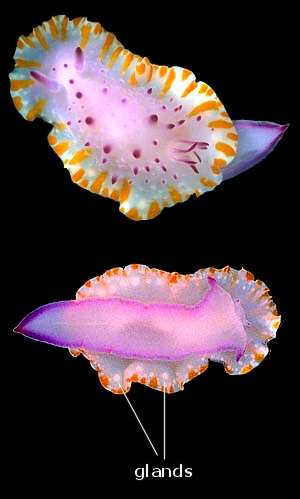
Aposematic colouration
PHOTO
Mexichromis macropus. Lower photo showing mantle glands containing posionous chemicals. Photos: Bill Rudman.
Many animals which are very distasteful, or poisonous to eat, have bright colour patterns. The bright colours are considered to be a message to potential predators warning them to stay away. We call such warning colouration Aposematic colouration. In one nudibranch family, the Chromodorididae, the colour patterns of many species are spectacular and obvious. Research in recent years has shown that these animals have specialised glands in their mantle which contain poisonous and distasteful chemicals from their sponge food. It is thought that by linking bright colour to bad tastes, these nudibranchs can teach fish and other potential predators to leave them alone.
In a development of this we often find geographic areas where groups of unrelated chromodorids have evolved very similar colour patterns, so that they share the load of teaching fish to leave the colour pattern alone. One example of this mimicry in southeastern Australia are a group of about ten red spotted species, some of which are very difficult to tell apart. Most chromodorids have these mantle glands.
A few examples include:
Mimicry between red spotted species in south-eastern Australia.
Mimicry between nudibranchs and flatworms .
Ceratosoma brevicaudatum
Chromodoris woodwardae
See also: Colour in sea slugs.
Authorship detailsRudman, W.B., 2004 (July 22) Aposematic colouration. [In] Sea Slug Forum. Australian Museum, Sydney. Available from http://www.seaslugforum.net/factsheet/aposemat
